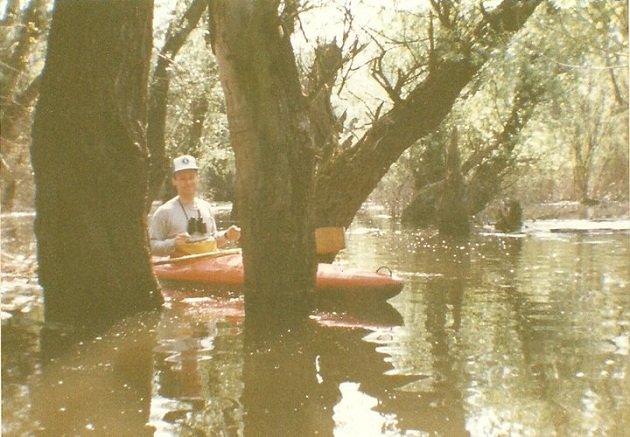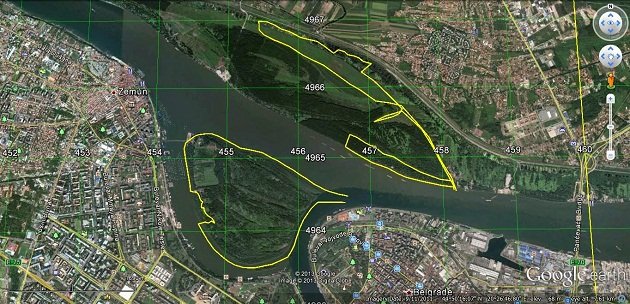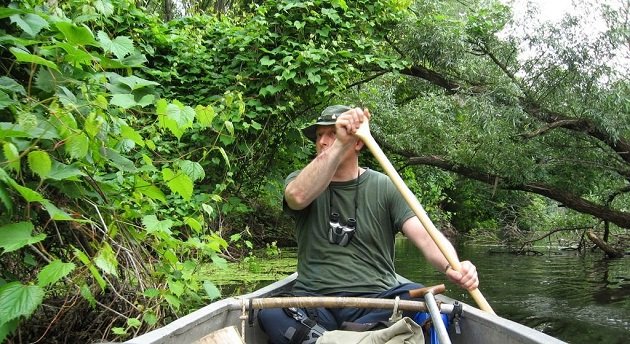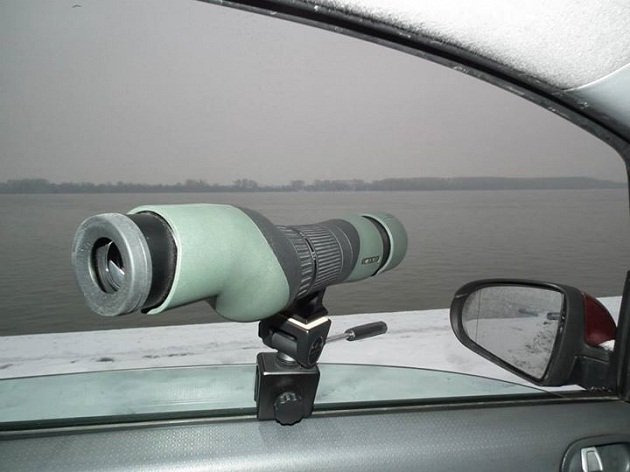
Since I have started to bird by kayak, it took me a lot of time to realise that paddling is not the synonym for birding and that I can bird without a paddle, although I cannot paddle without a pair of binoculars. Consequently, my first local patch becomes a largish Danube River floodzone opposite to Belgrade (Serbia) city centre (cover photo: April 1992).
And across the river starts the wilderness of Kozara backwaters (44°50’32.83″N, 20°27’10.89″E). Learning to steer and to stabilise the kayak with one-hand low brace, while holding the binoculars with my other hand, I was also learning my first birds. With about 110 recorded species, the Kozara becomes truly magical place when the Danube swells and reclaims what is rightfully his. Padding a kayak through the shallows, then it becomes possible to go everywhere, through the thickets of the invasive North American desert false indigo or indigo bush (Amorpha fruticosa) and through the plantations of clone poplars, but also through the indigenous willow and poplar riparian forests – a habitat that always held the most bird species. There were grumpy old fishermen, fishing through the closed season when the fish enter the backwaters to spawn, but also carrying handguns on their belts and assuming that, being armed and dangerous, they have every right to the area. Hence, I had the be equally grumpy to explain to them that I had an equal right to be there (equal right? armed with binoculars only?), and at the same time not grumpy enough to make them draw their guns (yep – it’s a true story, but do not trust the first impression: they were rough on the outside and soft on the inside, e.g. being fiercely protective of stray dogs and cats – that particular guy kept about five dogs and 15 cats, and they all lived together peacefully). Paddling in the rain through the yellow leaves of one long forgotten October, I saw my first Common Kingfisher there, like a fast-flying turquoise overtaking me in the raindrops mist.
On the other side of the river, underneath the very buttresses of the Belgrade Fortress, with its 170 recorded bird species lies the Veliko Ratno Island (44°49’53.20″N, 20°26’4.98″E). Unlike the Kozara backwaters, the entire island is overgrown with the indigenous willow and poplar forests. I remember the occasion, paddling around the island and having a female Mallard appearing from the willow grove some 10 metres ahead of the bow, helter-skelter running on the water, closely followed by the Northern Goshawk flying so low that its wingtips reached the water with every beat. To avoid the predator, the duck – dived, and that was the only time ever to observe this species doing so. All dabbling ducks can dive, but rarely do.
 The Kozara route (7.8mi, top) and the Veliko Ratno Island circumnavigation route (4.3mi, left; source: Google Earth).
The Kozara route (7.8mi, top) and the Veliko Ratno Island circumnavigation route (4.3mi, left; source: Google Earth).
Several years passed on and my home was now under the southern sky, on the outskirts of Gaborone, Botswana, not far from the Ngotwane River. My new local patch becomes the Ngotwane sewage ponds (24°40’51.20″S, 25°55’58.83″E). I think that the ponds were already out of use and filled with atmospheric water only. I am watching them at Google Earth now, they look so desolate, dry and devoid of life, and yet, after the rains, they harbour numerous Cattle Egrets, occasionally flushed by a passing African Fish Eagle, irresistible Black Crakes wanders the banks, together with Avocets, Black-winged Stilts and African Jacanas, plus Yellow-billed Kites and occasional African Harrier-Hawk flying above the ponds… That is where I watched a Nile Monitor swimming towards a tiny Little Grebe’s nest, also the pack of Vervet Monkeys, as well as those messengers from my other home, the White Storks.
As time goes by, my home was back in Belgrade, but now my paddling days were mostly over. Somehow, I started to visit the Ada Huja riverbank (44°49’24.49″N, 20°30’34.07″E), once an island, turned peninsula, overgrown with indigenous riparian forest, until, a few years ago, it was finally illegally buried under a thick layer of dirt, concrete and all sort of rubbish coming from various construction sites all over the city (the same process now continues in the riverbranch separating the Ada Huja from the bank, and officials are still blind and deaf).
Which birds can be seen there? Not much, species-wise, but what it lacks in the species richness, it certainly overcomes by sheer numbers, e.g. during the cold spell this January, I counted more than 30.000 individuals of six species of gulls. But, more than just quantity, this spot offers some quality birding, too. It is a winter trap for rare gulls and that is where I found the 4th Great Black-backed Gull for Serbia this winter, as well as the 6th Pallas’s Gull two winters ago. With the passing of winter, this patch loses its ornithological attractions and in spring, I move to the other bank of the Danube.
And that is where my latest patch is, some 15 minutes from my home: the Reva Wetland (44°50’52.12″N, 20°31’58.82″E). A century ago, this was the canal that was naturally draining the 400 km2 (155 mi2) of wetland, of which nowadays only narrow backwaters, like Kozara, and some smaller lakes, like Reva, remain. In the breeding season, some 50 species were recorded here, including Little Bittern and Golden Oriole, both unusually easy to see, as well as Ferruginous Duck, Red-backed Shrike and Penduline Tits that bred here this spring – but all I managed to see was their nest (again) and not the inhabitants! At this time of year, in an hour, this place offers 20 to 23 species, in hour and a half some 25 to 28. But more than just birding, it is a great place to simply meditate over a cup of take away coffee from the nearby petrol station and tie again one’s ruptured nerves.
This May, the rain was falling for five days without a break. I simply had to escape out, sit here and bird from the car, enjoying the coffee and more than 50 Whiskered Terns on and above the floating leaves of the European White Waterlily. Since they build their delicate nests on these leaves, I was already hoping that they will breed right there, but later I’ve found them only in small numbers. Recently I’ve discovered why: I’ve came earlier than usual to find a man paddling a packraft and picking the Waterlily flowers for the market – most likely, not for the first time.
Since the European White Waterlily is strictly protected under Serbian law, a week ago I informed the Republic Inspection for the Environmental Protection at the Ministry of Agriculture and Environmental Protection. I have not received any answer so far.















The eventual response from the officials came some six months later, well after the flowering season, when the police called me to come to the station to repeat everything and sign the statement.
They clearly didn’t intended to do anything and almost certainly knew the offender personally.